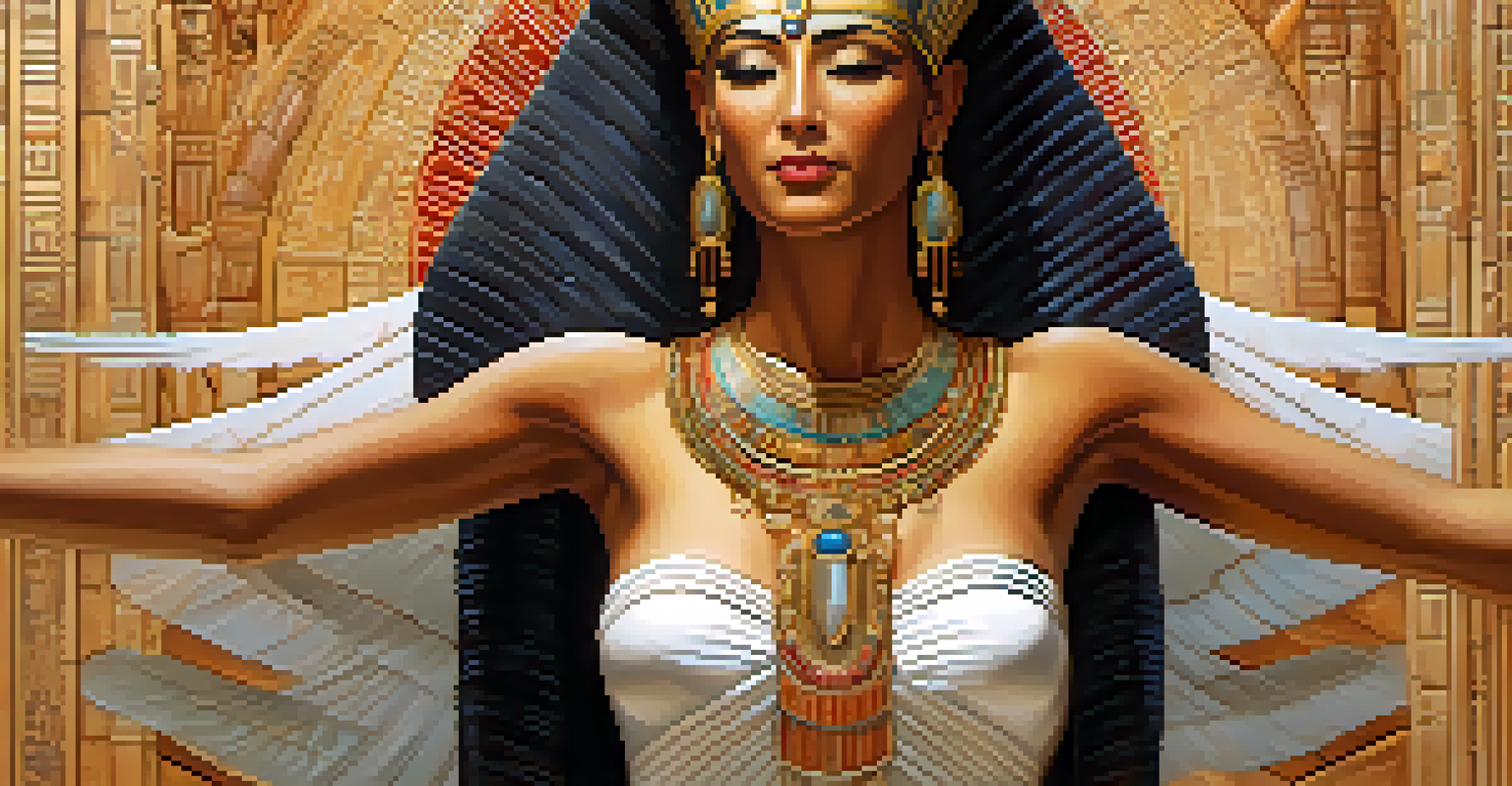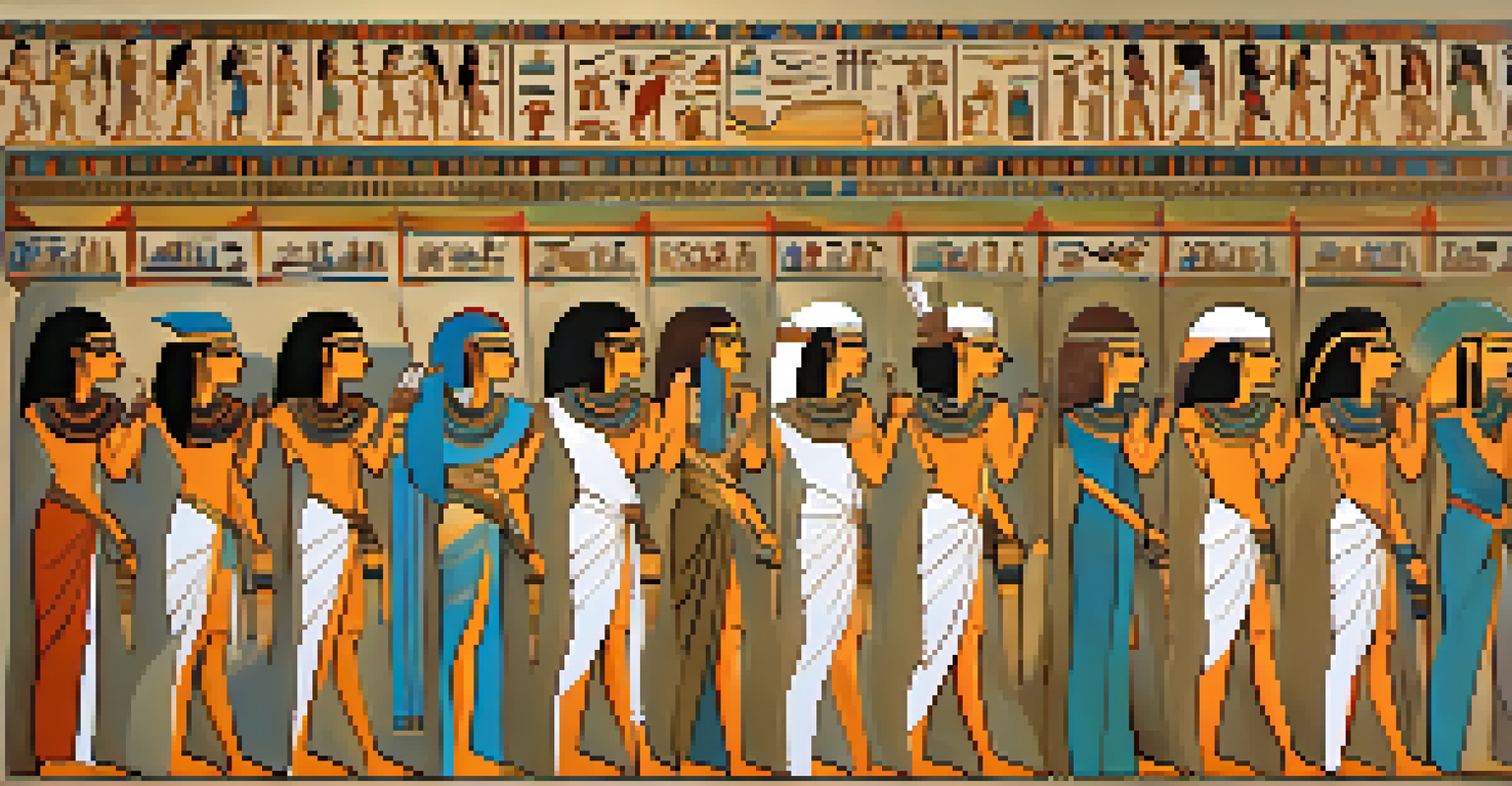Exploring the Body in Ancient Egyptian Art

The Significance of the Human Form in Ancient Egypt
In Ancient Egyptian culture, the human body was a crucial subject in art, reflecting both physical and spiritual ideals. The representation of the body was not merely for aesthetic purposes but also served religious and cultural functions. Artists aimed to capture the essence of life, emphasizing strength and beauty to convey a sense of eternity.
Art is the most beautiful of all lies.
Moreover, the body was seen as a vessel for the soul, which is why depictions were often idealized. The ancient Egyptians believed that perfect forms would ensure a successful journey in the afterlife. This belief influenced how they approached their art, focusing on creating timeless representations of human figures.
The significance of the human form extended beyond mere representation; it was about conveying stories and beliefs. The way bodies were portrayed in various contexts helped communicate social status, gender roles, and divine connections, making every piece of art a narrative in itself.
Common Artistic Styles and Techniques
Ancient Egyptian artists employed distinctive styles that have stood the test of time. One of the most notable features was the use of a composite view, where the head and legs were shown in profile while the torso faced forward. This technique ensured that all aspects of the body were visible, creating a more comprehensive representation.

Color was another pivotal element in these artworks, with specific hues symbolizing various meanings. For instance, skin tones varied by gender—men were often depicted with darker skin, while women were shown with lighter hues. These choices were more than aesthetic; they reinforced societal norms and roles within the culture.
Human Body as Spiritual Vessel
In Ancient Egypt, the human body was viewed as a vessel for the soul, influencing idealized depictions in art that aimed to ensure a successful afterlife.
Additionally, the use of scale played a significant role in conveying importance. Larger figures often represented gods, pharaohs, or significant individuals, thus emphasizing their status. This hierarchical approach allowed viewers to immediately identify the significance of the figures depicted.
Symbolism in the Human Body Representations
Every element of the human form in Egyptian art was laden with symbolism. The eyes, for example, were often depicted in a way that suggested they could see into the spiritual realm, bridging the gap between the earthly and the divine. This attention to detail highlighted the Egyptians' belief in the interconnectedness of life and the afterlife.
The body is a sacred garment.
Facial features were also stylized to convey specific characteristics or emotions, often reflecting the subject's attributes or status. For instance, a serene expression might indicate a divine nature, while slight frowns could represent the weight of responsibility. These features enriched the narrative behind each artwork.
Moreover, the positioning of limbs and the overall posture contributed to the story being told. A figure standing tall with arms at their sides often indicated strength and stability, while a crouching figure might suggest vulnerability or submission. Such symbolism was crucial in portraying complex ideas through seemingly simple forms.
The Role of Gender in Artistic Representation
Gender played an essential role in how bodies were depicted in Ancient Egyptian art. Men and women were often portrayed differently, with specific attributes highlighting their societal roles. For instance, men were frequently depicted as robust and muscular, symbolizing strength, while women were shown with softer, more curvaceous forms, representing fertility and beauty.
Additionally, the clothing and accessories worn by figures further emphasized gender roles. Men typically wore simple kilts, while women were often adorned with intricate jewelry and dresses, showcasing their status and femininity. These visual cues not only characterized the figures but also communicated societal expectations.
Symbolism in Artistic Techniques
Every aspect of the human form in Egyptian art was rich with symbolism, conveying complex ideas about status, gender, and spirituality through specific poses and features.
This distinct representation also extended to deities, where male gods were often associated with power and creation, while female deities were linked to fertility and nurturing. The art effectively reinforced the cultural norms surrounding gender, making it an invaluable resource for understanding Ancient Egyptian society.
The Influence of Religion on Body Representation
Religion was deeply interwoven with art in Ancient Egypt, influencing how the body was represented. Many artworks depicted gods and goddesses, illustrating their divine forms and significance in daily life. This connection between religion and the body was crucial, as it reinforced the belief in the afterlife and the importance of the human form in that journey.
Furthermore, tomb paintings often showcased the deceased in idealized forms, emphasizing their vitality and status in the afterlife. This practice was rooted in the belief that the soul would require a recognizable body in the next life. As a result, artists took great care to ensure that the figures were depicted as robust and youthful.
Ritualistic practices also influenced body representation, with certain poses and gestures symbolizing specific religious beliefs. For instance, outstretched arms were often depicted in prayer or supplication, signaling a connection between the earthly realm and the divine. This blending of art and spirituality made the human body a powerful focal point in Ancient Egyptian culture.
The Evolution of Body Depictions Over Time
As Ancient Egyptian civilization evolved, so too did the representation of the human body in art. Early dynastic periods showcased a more rigid and formulaic approach, with strict adherence to proportions and pose. However, over time, artists began to experiment with more dynamic poses and emotional expressions, reflecting a shift in cultural values.
The influence of foreign cultures also played a role in this evolution. As Egypt interacted with neighboring civilizations, new artistic techniques and styles began to emerge. This fusion resulted in a richer variety of representations that incorporated both traditional Egyptian motifs and fresh perspectives.
Evolution of Artistic Representation
As Ancient Egyptian civilization progressed, the representation of the human body evolved from rigid styles to more naturalistic forms, reflecting broader cultural shifts and influences.
By the later periods, such as the Greco-Roman era, the depiction of the body had become more naturalistic. Artists began to focus on realism and anatomical accuracy, which marked a significant departure from earlier stylizations. This evolution illustrates the dynamic nature of art, continuously adapting to reflect the changing cultural landscape.
Legacy of Ancient Egyptian Body Art in Modern Culture
The legacy of Ancient Egyptian art, particularly in how the body was depicted, continues to resonate in modern culture. From fashion to film, the visual elements established by ancient artists have influenced countless creators. For example, contemporary fashion often draws inspiration from the elaborate designs and colors found in Egyptian art, showcasing a blend of ancient and modern aesthetics.
In addition, the fascination with Ancient Egyptian culture has led to numerous films and literature exploring its themes and visuals. These portrayals often reference the iconic body representations, capturing the imagination of audiences and keeping the essence of this art form alive.

Furthermore, modern artists frequently revisit these themes, using the human form to explore contemporary issues while paying homage to the ancient techniques and symbolism. This dialogue between past and present highlights the enduring impact of Ancient Egyptian art on our collective cultural identity.